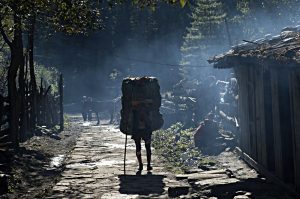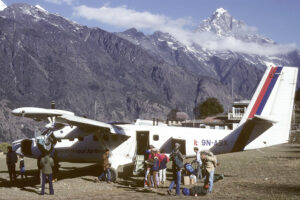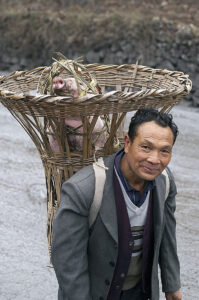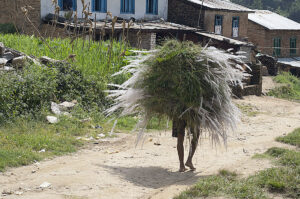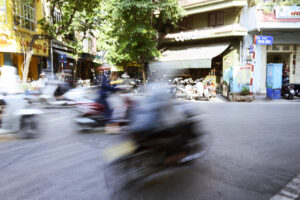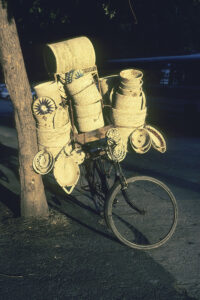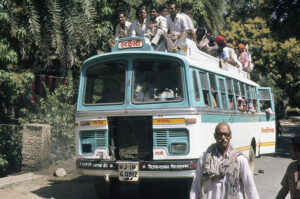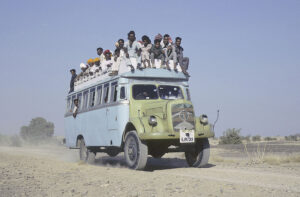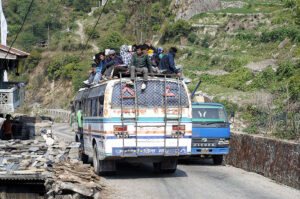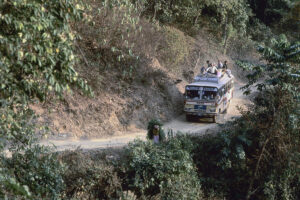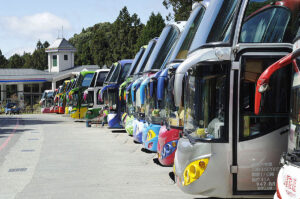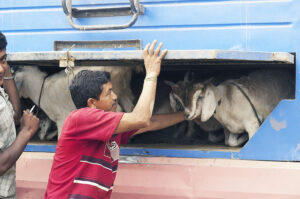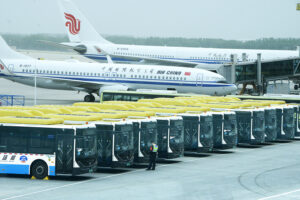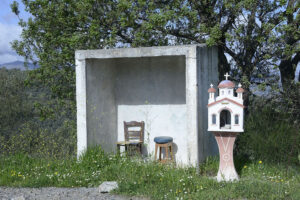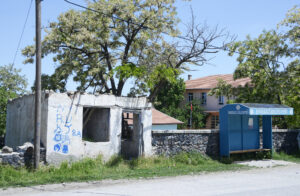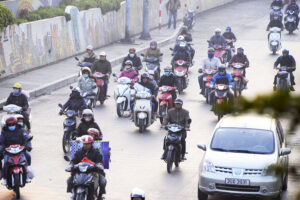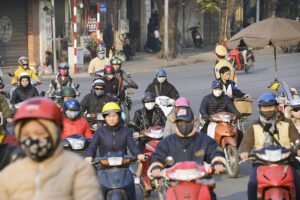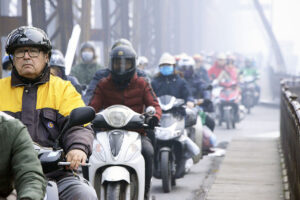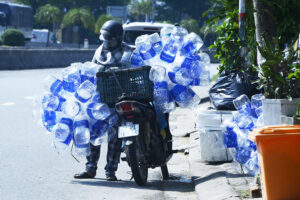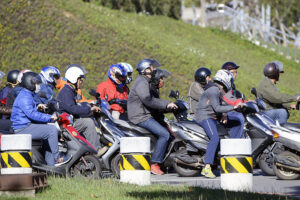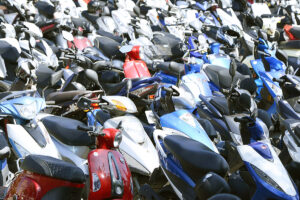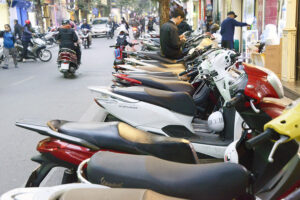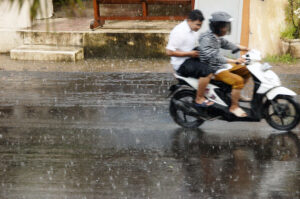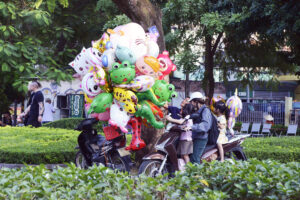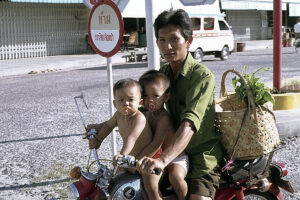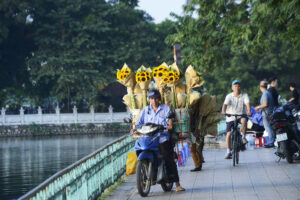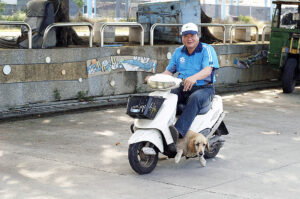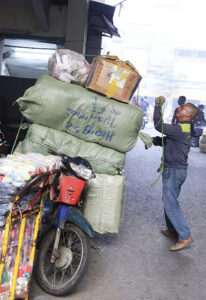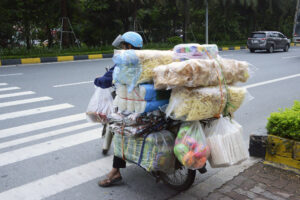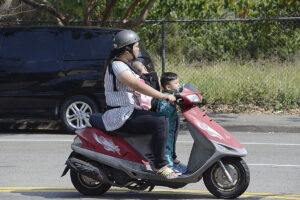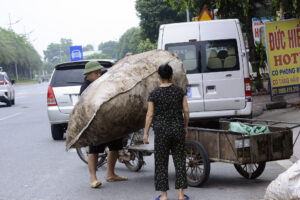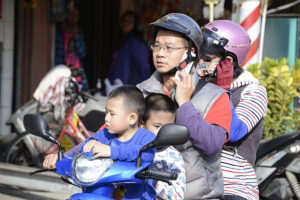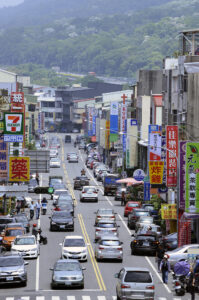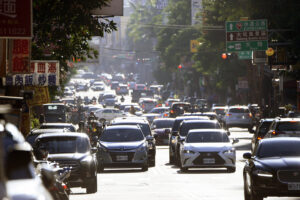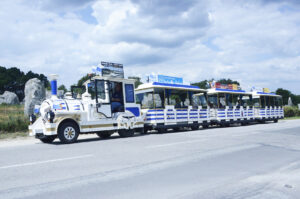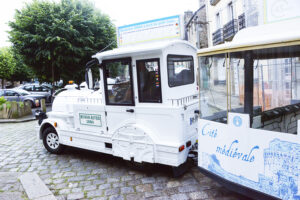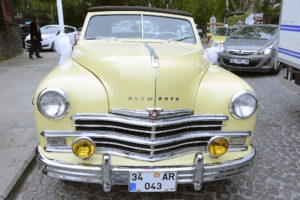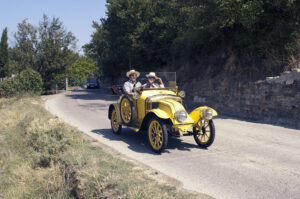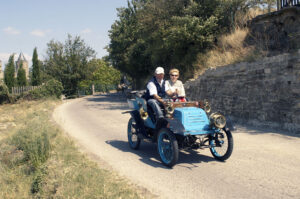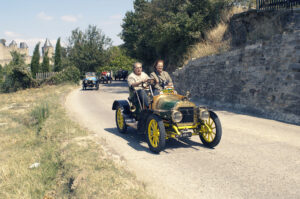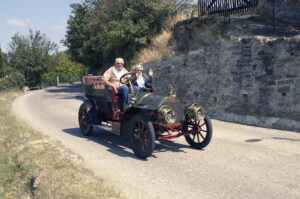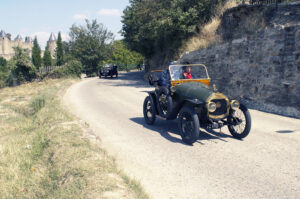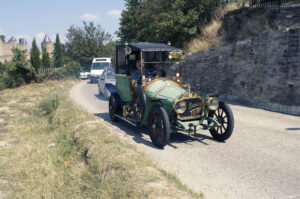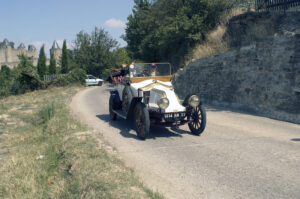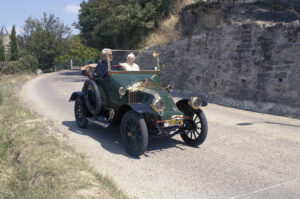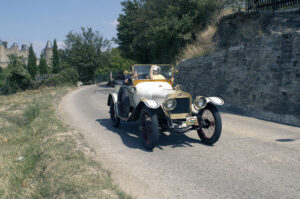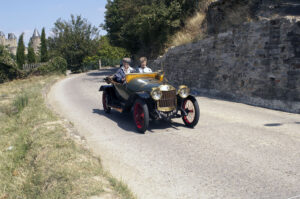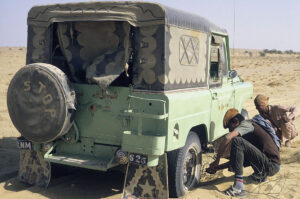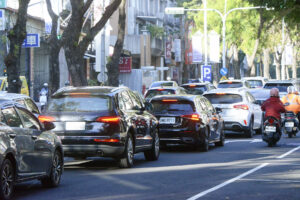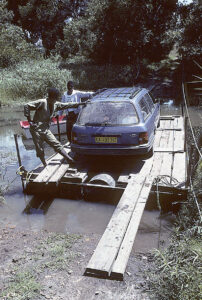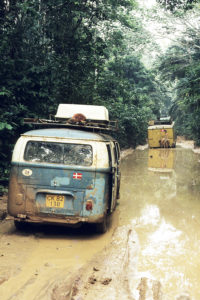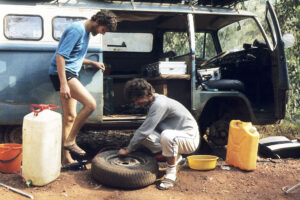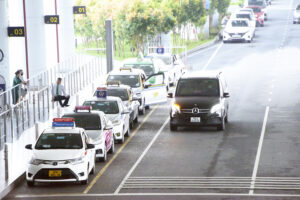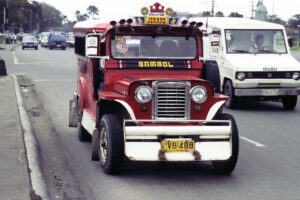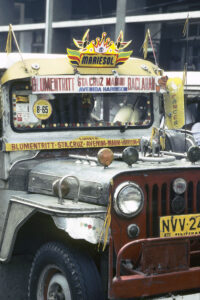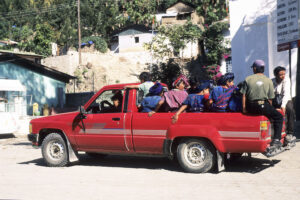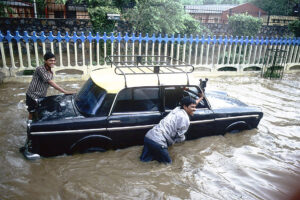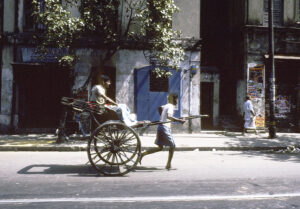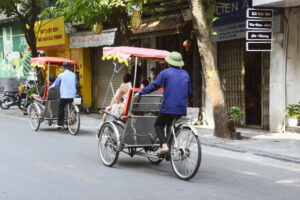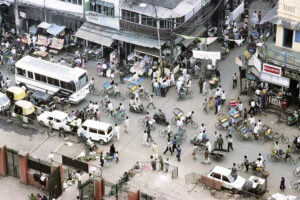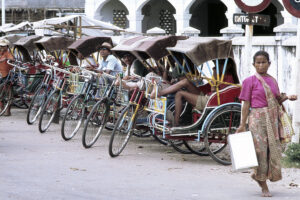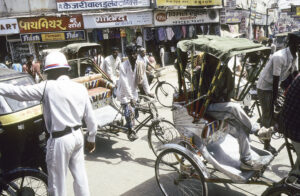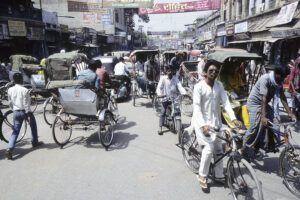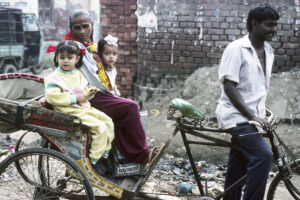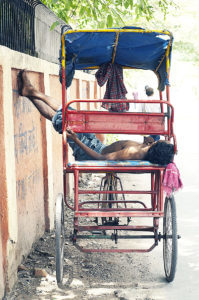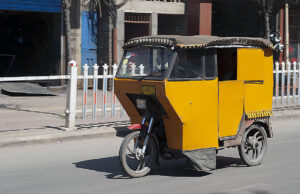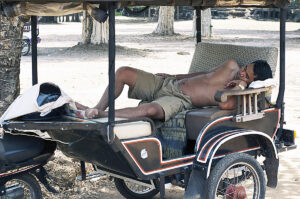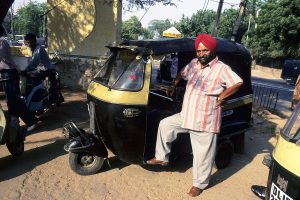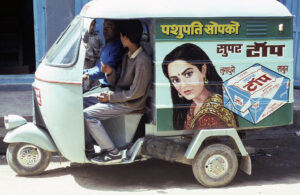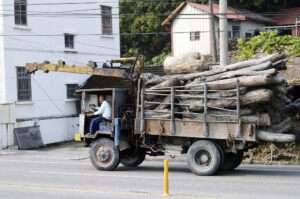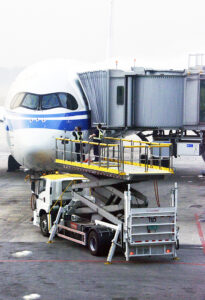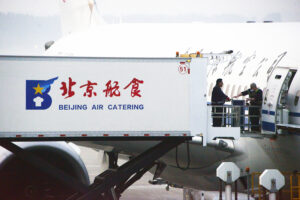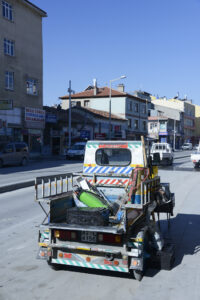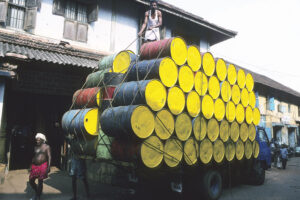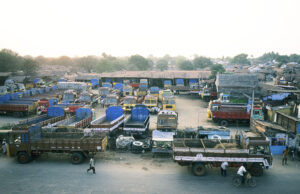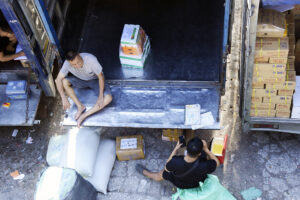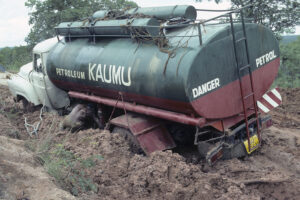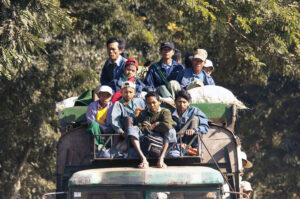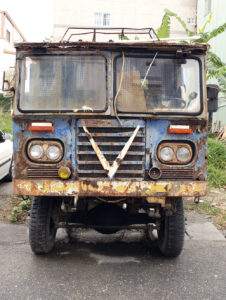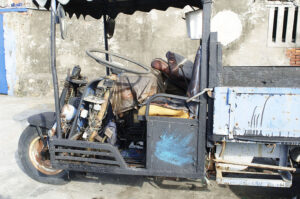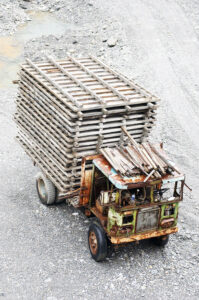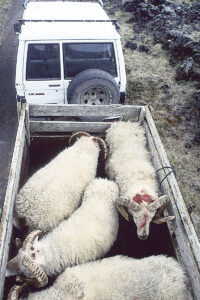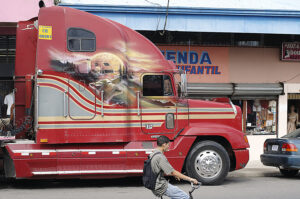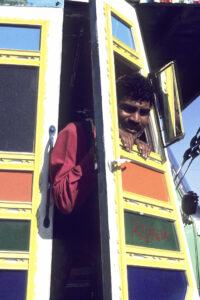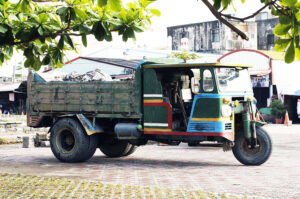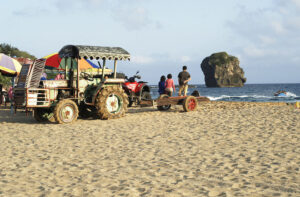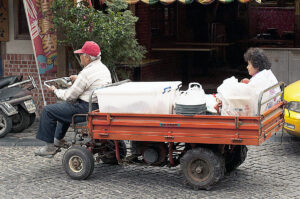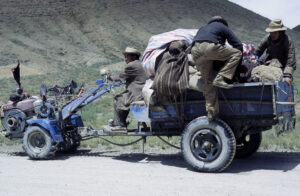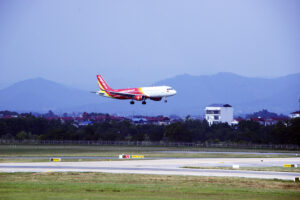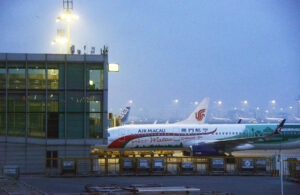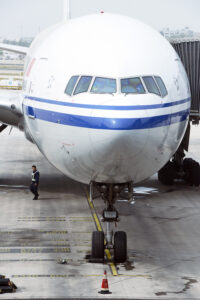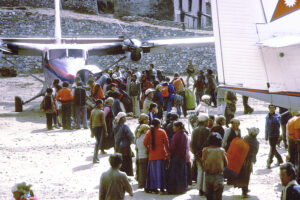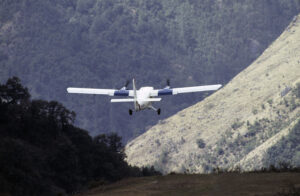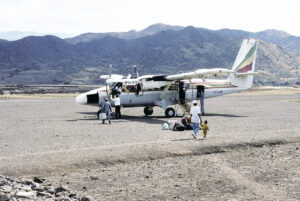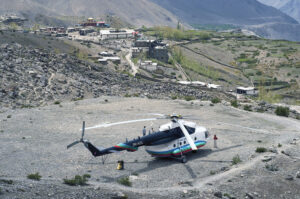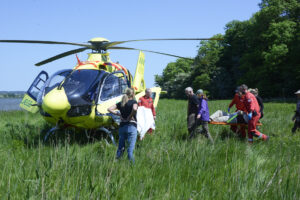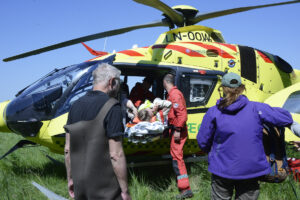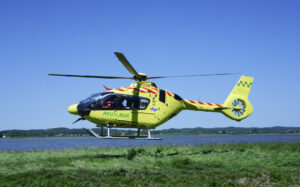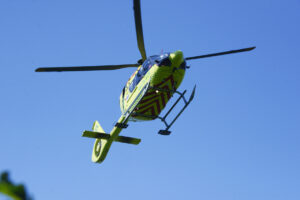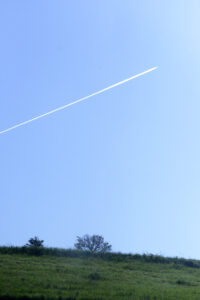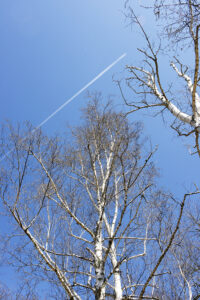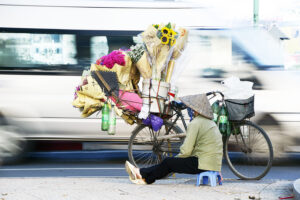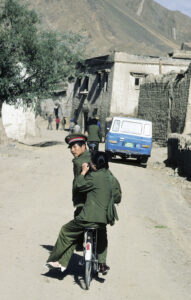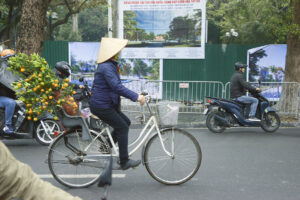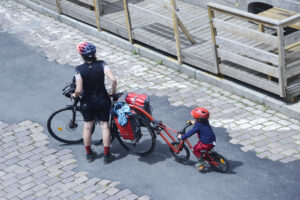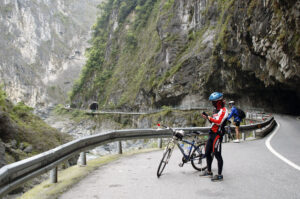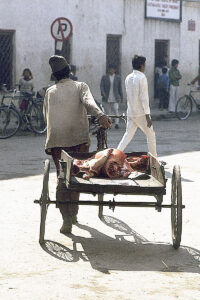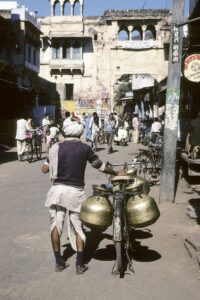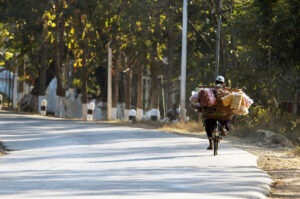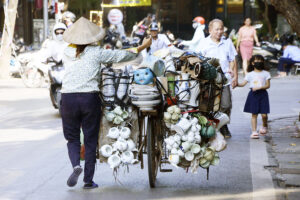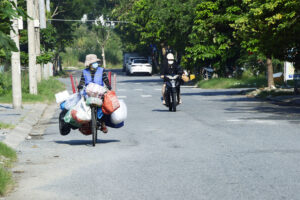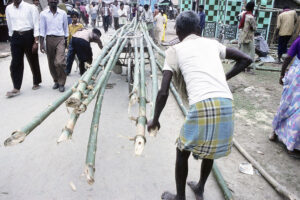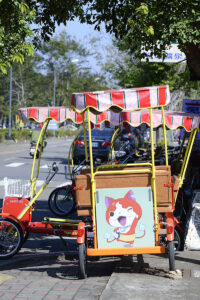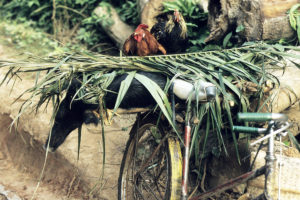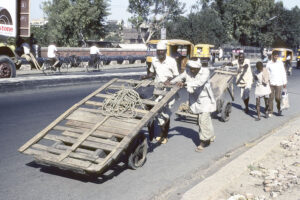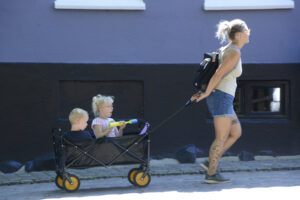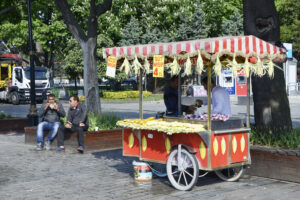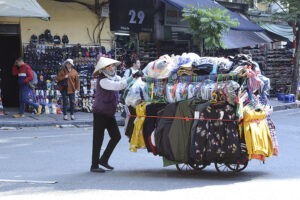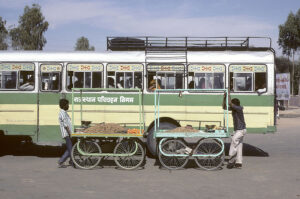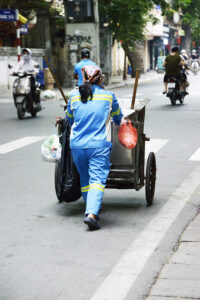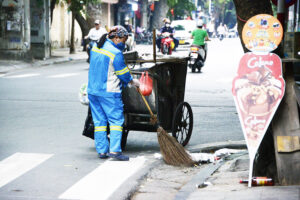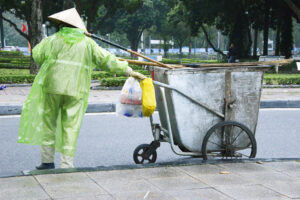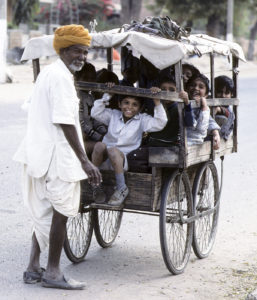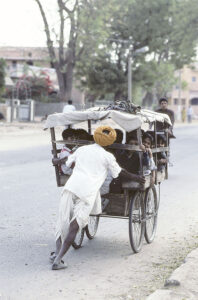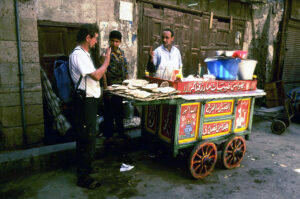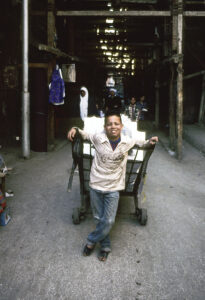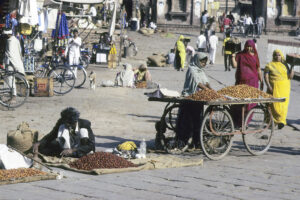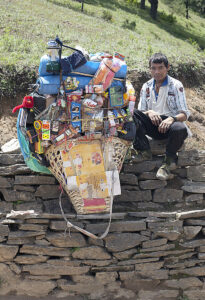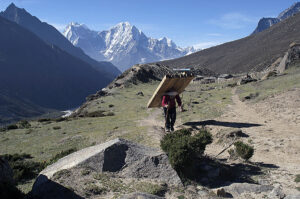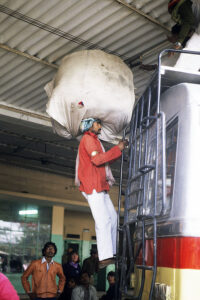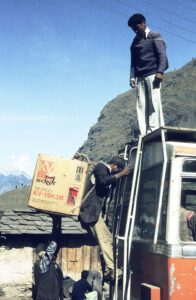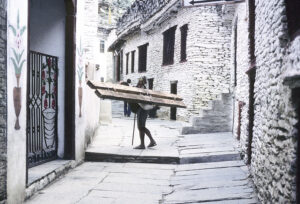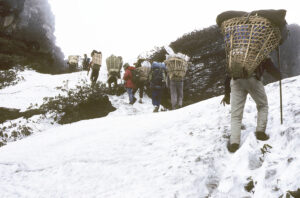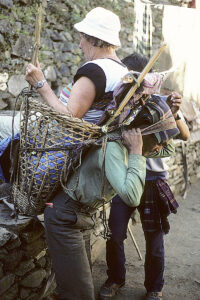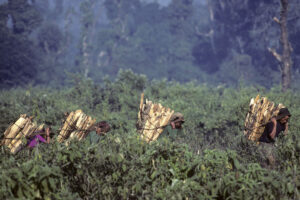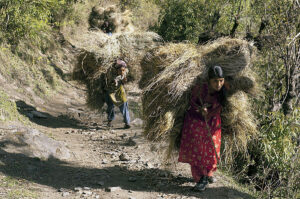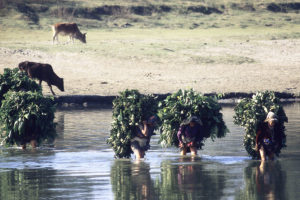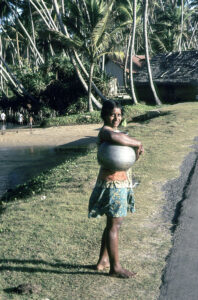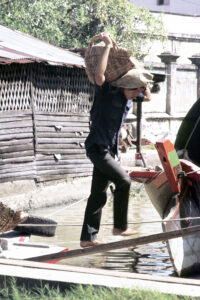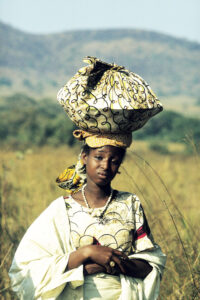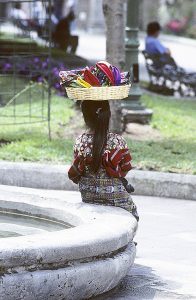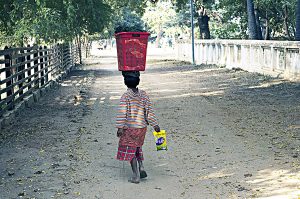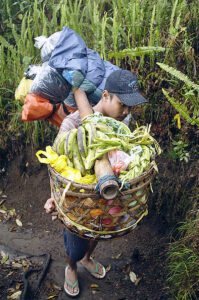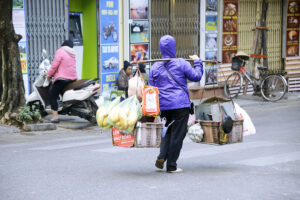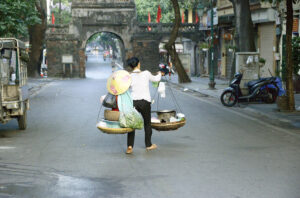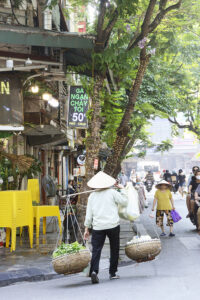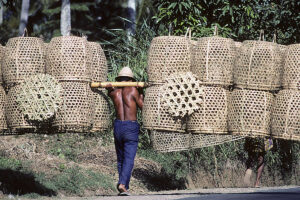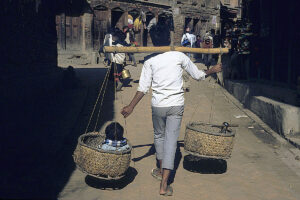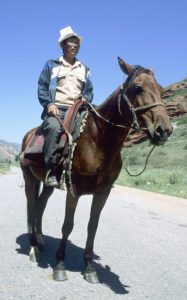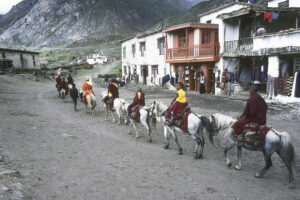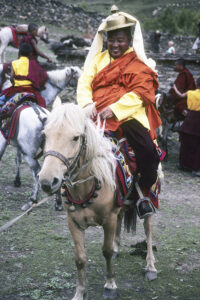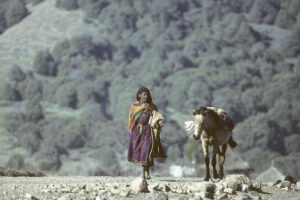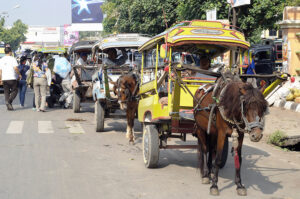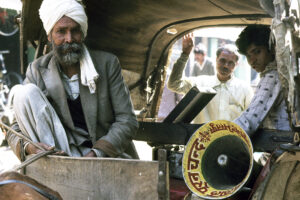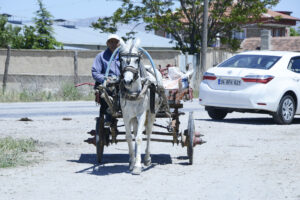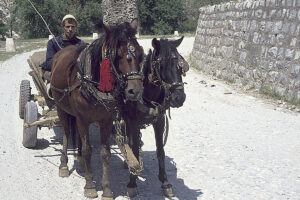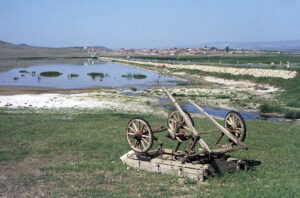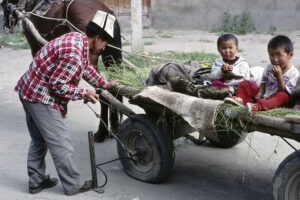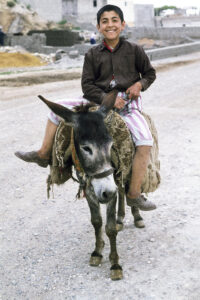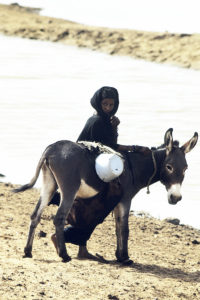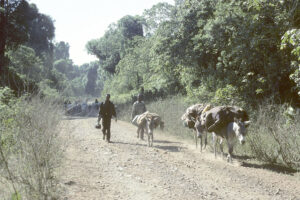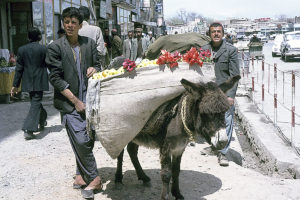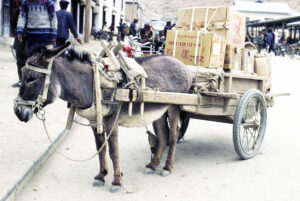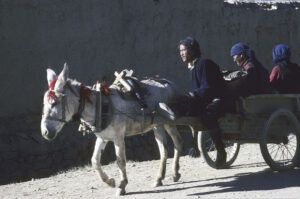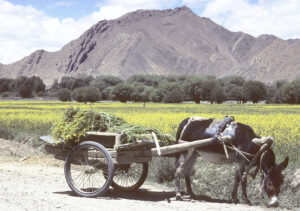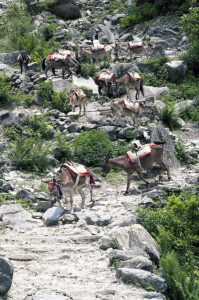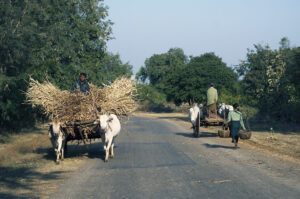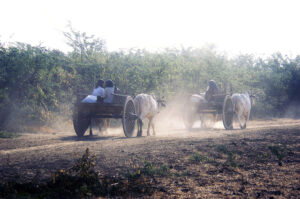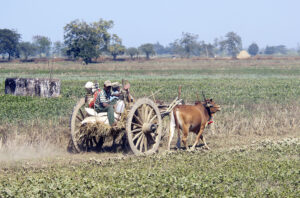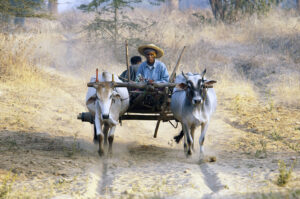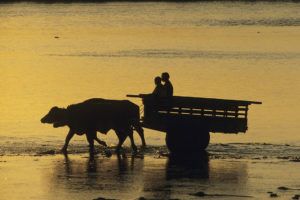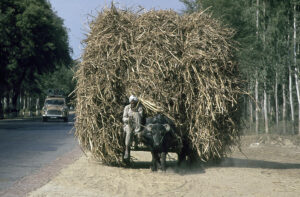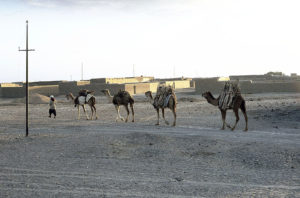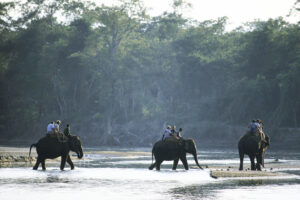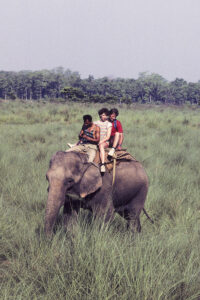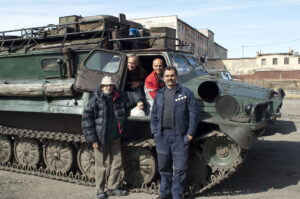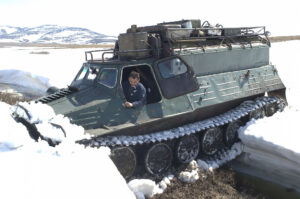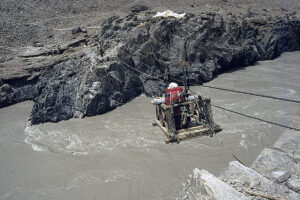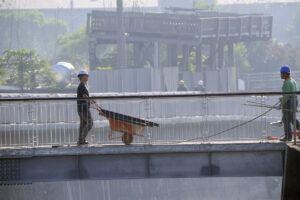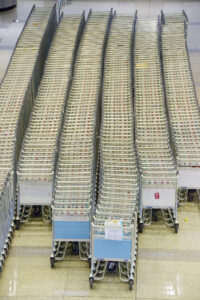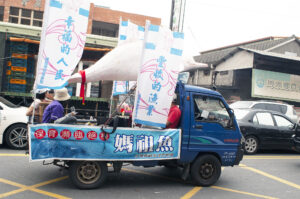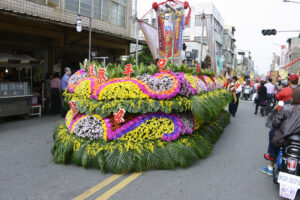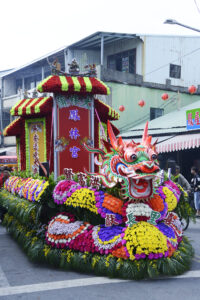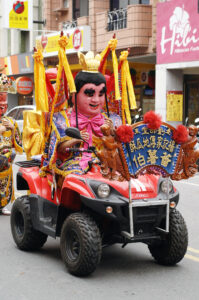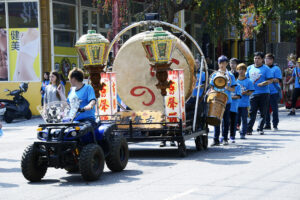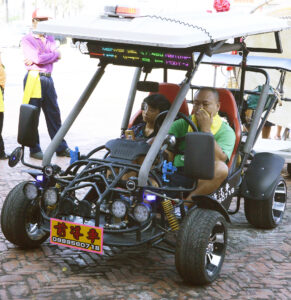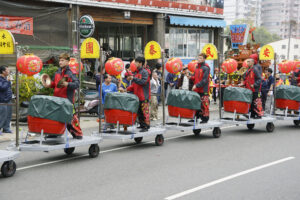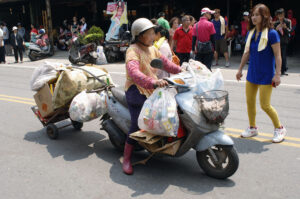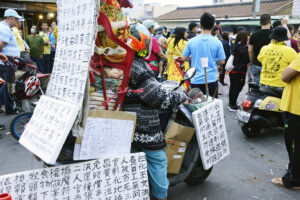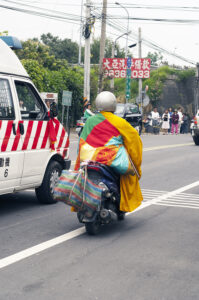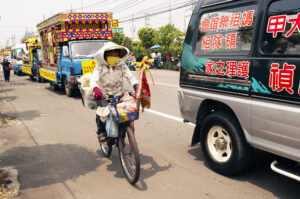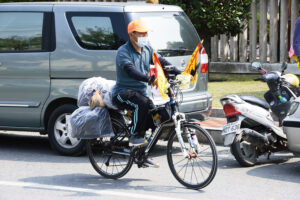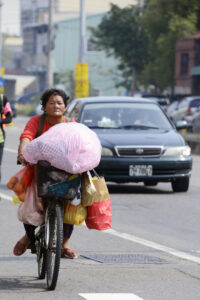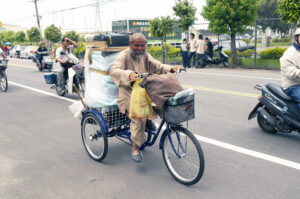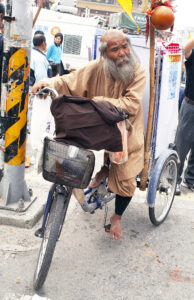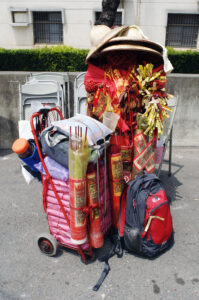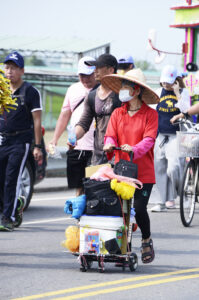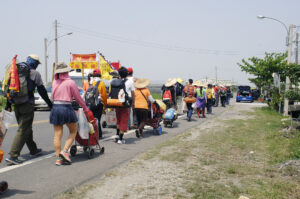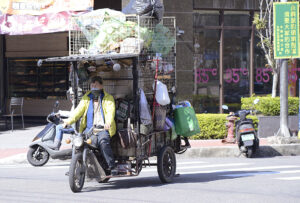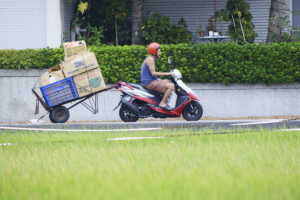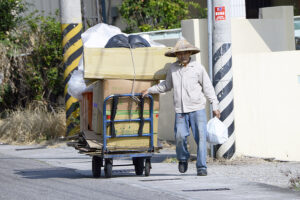Transportation
Early in the morning, a Nepalese porter is passing through kitchen smoke, seeping out from a house in the village of Koto, Marsyangdi Valley, central Nepal. (Photo copyright © by Kaj Halberg)
Motorcyclist with wife, children, and firewood, Banteay Kdei, Angkor, Cambodia. (Photo copyright © by Kaj Halberg)
Twin Otter, waiting to take off from the air strip in Lukla, eastern Nepal. (Photo copyright © by Kaj Halberg)
A seemingly endless and straight road, east of Panamint Oasis, Death Valley National Park, California. – Well, there is a single bend far ahead! (Photo copyright © by Kaj Halberg)
This man in Suicheng, Guizhou Province, China, has acquired a pig at a market and is now carrying it to his home in a basket. (Photo copyright © by Kaj Halberg)
Off-road vehicle, a cross between a car and a caterpillar, Akureyri, Iceland. (Photo copyright © by Kaj Halberg)
A farmer in Dhobichour, Helambu, central Nepal, carries a huge load of silver-headed grass to his farm, to be used as fodder. (Photo copyright © by Kaj Halberg)
Busy traffic, Hanoi, Vietnam. (Photo copyright © by Kaj Halberg)
This parked bicycle, laden with baskets, is illuminated by the evening sun, Delhi, India. (Photo copyright © by Kaj Halberg)
”While waiting for a third bus in Sikar, I am bothered by beggars, shoe-shiners, and snot-nosed kids. The queue in front of the ticket office is unusually long, but luckily the conductor from the previous bus spots me and drags me in front of the queue.
This act is indeed very nice of him, but, alas, of very little use, because when our bus finally arrives, it’s already packed with passengers. This fact doesn’t seem to subdue anyone – they push and shove and shout, and when the bus leaves the station, there must be about 150 passengers, inside, on the roof, and in every other place a person can possibly cling to.
Inside the bus, an obese man offers me his seat, my protests being to no avail. That’s Indians for you! The most paradoxical people in the world. For two hours, I am seated in a most inconvenient position, before the crowds thin out a bit.”
Excerpt from my diary during a trip to India, taken from the page Travel episodes – India 1979: Hunting blackbuck with camera.
Buses
Buses, loaded to their bursting point, are a very common sight in India and Nepal.
Rajasthan, India. (Photos copyright © by Kaj Halberg)
Bharku, Langtang National Park, Nepal. (Photo copyright © by Kaj Halberg)
An overloaded bus makes its way along a winding gravel road between Chisopani and Lodia, Ilam, eastern Nepal. The woman in the foreground is carrying a huge load of fodder, which she has collected in the forest. (Photo copyright © by Kaj Halberg)
On board a crowded bus, women bring large baskets of cucumbers to be sold at a market in the city of Pokhara, Nepal. (Photo copyright © by Kaj Halberg)
Numerous tourist buses are lined up during the ‘Cherry Blossom Festival’, celebrated in the town of Alishan, central Taiwan. (Photo copyright © by Kaj Halberg)
Instead of spending many hours herding his goats along the road to the market, this man is stuffing them into the luggage compartment of a bus, near Baunepat, central Nepal. The domestic goat is described on the page Animals: Animals as servants of Man. (Photo copyright © by Kaj Halberg)
Airport buses, Beijing Airport. (Photo copyright © by Kaj Halberg)
Numerous tourist buses, lined up at Yeliou Geopark, northern Taiwan. (Photo copyright © by Kaj Halberg)
‘Waiting room’ at a bus stop in the village of Karanao, near Laki, Crete. A road altar has been erected next to it, in case you might want to worship while waiting for the bus. Other pictures, depicting road altars, are shown on the page Religion: Christianity. (Photo copyright © by Kaj Halberg)
The ’waiting room’ at this bus stop in the town of Kurseong, West Bengal, India, is not as fancy as the one in the picture above. A small boy has climbed onto the roof of the shed. (Photo copyright © by Kaj Halberg)
Old an new ‘waiting room’ at a bus stop, near Karapinar, east of Konya, Turkey. (Photo copyright © by Kaj Halberg)
Scooters and motorcycles
These are very common means of transportation in many Asian countries. Every morning and late afternoon, millions of people go to work, driving on these vehicles. Mopeds, which are so common in the West, is a rare sight in the Far East.
Morning traffic, Hanoi, Vietnam. (Photos copyright © by Kaj Halberg)
Many empty water containers can be tied to a motorcycle! – Da Nang, Vietnam. (Photo copyright © by Kaj Halberg)
In the morning, scooter drivers are waiting for green light at a crossing, Taichung, Taiwan. (Photo copyright © by Kaj Halberg)
Parked scooters, Taichung, Taiwan (top), and Hanoi, Vietnam. (Photos copyright © by Kaj Halberg)
Despite heavy rain, this motorcyclist continues his journey through the town of Senggigi, Lombok, Indonesia. (Photo copyright © by Kaj Halberg)
This man in Hanoi, Vietnam, is selling balloons, which he has tied to his motorcycle. (Photo copyright © by Kaj Halberg)
Three on a motorcycle: Father and twin infant sons, Phuket, Thailand. (Photo copyright © by Kaj Halberg)
Transporting flowers on a scooter and a motorcycle, Hanoi, Vietnam. (Photos copyright © by Kaj Halberg)
In the town of Fangliao, western Taiwan, I met this man and his golden retriever, which was too old (and too overweight) to run behind his master’s scooter, so he gets a lift in this way. Note that the tail is dragging along the ground. – The long relationship between the dog and Man is described on the page Animals: Animals as servants of Man. (Photo copyright © by Kaj Halberg)
Large loads on motorcycles, Hanoi, Vietnam. (Photos copyright © by Kaj Halberg)
Three on a scooter, Taichung, Taiwan. (Photo copyright © by Kaj Halberg)
A gigantic sack of garbage is loaded onto a wagon, pulled by a motorcycle, Hanoi, Vietnam. (Photo copyright © by Kaj Halberg)
The following two pictures, from the village of Dalinpo, near Kaohsiung, southern Taiwan, show different attitudes when it comes to transporting children on scooters.
This father has equipped his children with safety helmets, but the safety of his own head seems to be of less importance. (Photo copyright © by Kaj Halberg)
As a contrast, this couple, talking on their cell phones, are wearing helmets, whereas their children’s heads seem less precious. (Photo copyright © by Kaj Halberg)
These scooters in Hanoi, Vietnam, have seen better days. (Photo copyright © by Kaj Halberg)
Discarded motorcycles and scooters, piling up along the Vishnumati River, Kathmandu, Nepal. (Photo copyright © by Kaj Halberg)
Heavy traffic, Sanyi (top), and Taichung, Taiwan. (Photos copyright © by Kaj Halberg)
These cars, which are supposed to look like train locomotives, bring tourists around in the megalith area near Carnac (top), and in the city of Dinan, both Brittany. Carnac is described on the page Culture: Megaliths. (Photos copyright © by Kaj Halberg)
This fine old Plymouth serves as a wedding car, Istanbul, Turkey. (Photos copyright © by Kaj Halberg)
The following pictures show veteran cars, participating in a ‘race’, Carcassonne, France.
(Photos copyright © by Kaj Halberg)
Traffic in rainy weather, Taichung, Taiwan. (Photos copyright © by Kaj Halberg)
In tropical countries, torrential rain often turns roads into a hopeless mire. This picture shows a road between Kota Kinabalu and Ranau, Sabah, Borneo. (Photo copyright © by Kaj Halberg)
This jeep is stuck in soft sand, Thar Desert, Rajasthan, India. (Photo copyright © by Kaj Halberg)
Cars, waiting for green light, Taichung, Taiwan. (Photo copyright © by Kaj Halberg)
In Kasanka National Park, northern Zambia, this pontoon ferry brings my car across a small river. (Photo copyright © by Kaj Halberg)
In the winter 1980-1981, Steffen Madsen, Johnny Kristensen and I travelled in an old Volkswagen van across Africa, from Morocco southwards to Zaire, thence eastwards to Tanzania and Kenya. As it turned out, it was indeed an arduous journey, during which our poor car broke down several times.
In Bangui, Central African Republic, we got acquainted with five Germans, who also travelled by car. When we had obtained visas for Zaire, we all went by ferry across the Oubangui River, continuing by road from Zongo to Boyabu.
The first half of our journey is related on the page Travel episodes – Africa 1980-1981: An arduous journey across Africa.
The road between Zongo and Boyabu was in a horrible condition, and soon serious troubles began. Here we prepare to cross a muddy section of the road. (Photo copyright © by Kaj Halberg)
After getting stuck in the mudhole above, we had to remove the engine from our Volkswagen to clean it. Our German friends Jürgen (left) and Wolfgang are surveying the damage. (Photo copyright © by Kaj Halberg)
During the trip we experienced several punctures. In this picture from Rwanda, my companions Steffen and Johnny are pumping up a mended tube. (Photo copyright © by Kaj Halberg)
Taxis
Taxis, lined up outside Hanoi Airport, Vietnam. (Photo copyright © by Kaj Halberg)
So-called jeepneys are a common means of transportation in Manila, Philippines. (Photos copyright © by Kaj Halberg)
Passengers on a pick-up-taxi, Santa Catarina Palomo, Lago Atitlan, Guatemala. Women in this area are known for their blue huipil, a blouse made from cloth woven by themselves. (Photo copyright © by Kaj Halberg)
A heavy monsoon shower has flooded this street in Delhi, India, and a taxi driver and his customer must push the vehicle through the water. They seem to bear their mishap good-naturedly. (Photo copyright © by Kaj Halberg)
In the old days, transportation of people in Asian cities mainly took place in so-called rickshaws, drawn by running men, in India called rickshaw wallahs. Later, their role was taken over by three-wheeled taxi-vehicles: bicycles, scooters (in India called tempo), and motorcycles (in Cambodia called tuk-tuk).
Today, running rickshaw wallahs are a rare sight. This picture was taken in Kolkata (Calcutta), north-eastern India, in 1994. (Photo copyright © by Kaj Halberg)
Cycle rickshaws, Hanoi, Vietnam. (Photo copyright © by Kaj Halberg)
Numerous cycle rickshaws and other traffic, seen from Jama Mashid (the Friday Mosque), Old Delhi, India. (Photo copyright © by Kaj Halberg)
Wearing a hat against the winter cold (but no socks), this tired rickshaw driver is napping on his cycle, Haridwar, Uttarakhand, India. (Photo copyright © by Kaj Halberg)
Cycle rickshaw drivers, waiting for customers, Sibolga, Sumatra, Indonesia. (Photo copyright © by Kaj Halberg)
A police officer does his best to direct a chaotic mess of cycle rickshaws, bicyclists, and scooter taxis, Varanasi, Uttar Pradesh, India. (Photos copyright © by Kaj Halberg)
Cycle rickshaw, Amritsar, Punjab, India. (Photo copyright © by Kaj Halberg)
Relaxed rickshaw driver, sleeping on his cycle, Delhi, India. (Photo copyright © by Kaj Halberg)
Tiny motorcycle taxis ply the streets of Weining, Guizhou Province, China. (Photo copyright © by Kaj Halberg)
While waiting for his customers to return from a visit to Angkor Thom, Cambodia, the driver of this tuk-tuk, or motorcycle taxi, takes a nap. (Photo copyright © by Kaj Halberg)
Sikhs, who may easily be identified by their immaculately bound turbans, are often employed as motor rickshaws drivers, like this one in Delhi, India. Sikhism is described on the page Religion: Sikhism. (Photo copyright © by Kaj Halberg)
This scooter taxi (tempo) is advertizing soap, Patan, Kathmandu Valley, Nepal. (Photo copyright © by Kaj Halberg)
Trucks
Trucks, or lorries, are large cars, constructed for transportation of huge or heavy loads.
Truck, transporting logs, Linbei Chukou, near Linnei, western Taiwan. (Photo copyright © by Kaj Halberg)
Special trucks with a lift, designed for bringing goods on board aeroplanes, Beijing Airport. (Photos copyright © by Kaj Halberg)
Truck, transporting people and goats, Eceabat, western Turkey. (Photo copyright © by Kaj Halberg)
Loading chairs onto a truck, Hanoi, Vietnam. (Photo copyright © by Kaj Halberg)
Mini-truck with spraying equipment, Karapinar, east of Konya, Turkey. (Photo copyright © by Kaj Halberg)
This truck in Kochi, Kerala, South India, has been loaded with an enormous amount of oil drums. Hopefully, they are empty! (Photo copyright © by Kaj Halberg)
This lorry is driving on board a ferry across the Tsangpo River (Brahmaputra), between Shishapangma and Saga, Tibet. Buddhist prayer flags are fluttering in the wind. (Photo copyright © by Kaj Halberg)
Early morning at a truck stop, Pollachi, Tamil Nadu, India. (Photo copyright © by Kaj Halberg)
These men are resting after emptying a truck, Hanoi, Vietnam. (Photo copyright © by Kaj Halberg)
This petrol truck is stuck on a muddy road between Namtumbo and Tunduru, southern Tanzania. The driver is removing mud from under the truck. (Photo copyright © by Kaj Halberg)
Lorries, transporting gravel from a river bed, Aowanda National Forest, Taiwan. (Photo copyright © by Kaj Halberg)
These trucks in central Myanmar also function as buses. (Photos copyright © by Kaj Halberg)
Well-used, but still functioning lorries, Taitung (top), Fangliao (centre), and Jhiben River, all in Taiwan. (Photos copyright © by Kaj Halberg)
Transporting sheep on a truck, Aðaldal, northern Iceland. (Photo copyright © by Kaj Halberg)
This truck in the town of Cariari, Costa Rica, is decorated with a painting of a wolf, the sun, and a truck, on which the same image is repeated. (Photo copyright © by Kaj Halberg)
Colourful trucks, near Khanpur, Sind, Pakistan (top), and Fangliao, western Taiwan. (Photos copyright © by Kaj Halberg)
Tractors
This tractor is used when transporting rubber dinghies to the beach, Chuanfan (‘Sail Rock’), Kenting National Park, Taiwan. (Photo copyright © by Kaj Halberg)
An elderly man in the town of Shenghsing, Taiwan, transports goods (and his wife) on a mini-tractor. (Photo copyright © by Kaj Halberg)
This mini-tractor in Shigatse, Tibet, is transporting goods and people. (Photo copyright © by Kaj Halberg)
Boats and ships
Transportation with boats and ships is described on the page Culture: Boats and ships.
Trains
Train transportation is described on the page Culture: Railways.
Aeroplanes
Jet plane, just about to land, Hanoi Airport, Vietnam. (Photo copyright © by Kaj Halberg)
Jet planes, Beijing Airport. (Photos copyright © by Kaj Halberg)
Twin Otters are small aeroplanes with two engines, propellers, and the wings above the doors. They are used all over the world, as they are known for their reliability and short take-off and landing performance.
In Lukla, eastern Nepal, the weather is highly unpredictable, and as the Twin Otters can only land in fair weather, people must often wait for days for the planes to arrive. Once the weather permits, the planes fly back and forth between Lukla and Kathmandu, until all passengers have been served.
(Photo John Burke, copyright © by Kaj Halberg)
This Twin Otter is racing down the short and steep air strip in Lukla to get sufficient speed to take off, before levitating over an abyss. A rather hair-raising experience, I can tell you! (Photo copyright © by Kaj Halberg)
Twin Otter on the airstrip at Lalibela, Ethiopia. (Photo copyright © by Kaj Halberg)
This helicopter brings pilgrims to and from the Hindu temple Muktinath, Jhong River Valley, Mustang, Nepal. (Photo copyright © by Kaj Halberg)
A rescue helicopter brings a woman, who has broken her leg, from Nature Reserve Vorsø, Horsens Fjord, Denmark, to a nearby hospital. (Photos copyright © by Kaj Halberg)
Condensation trails (often shortened to contrails), or vapour trails, are long, narrow, white clouds, produced by airplane engine exhaust, which contains water vapour as well as soot and dust particles from the turbines. The trails are only formed at very low temperatures (around -40°C), where the water vapour turns into tiny ice crystals, which, together with the soot and dust particles, form condensation nuclei. These nuclei make it possible for the water vapour to concentrate, hereby forming the cloud.
Condensed exhaust from a jet plane draws white lines across a bright blue sky behind smoking chimneys of a fish smokehouse, Hasle, Bornholm, Denmark. (Photo copyright © by Kaj Halberg)
Condensation trails, Denmark. (Photos copyright © by Kaj Halberg)
Jet plane, passing over paper birches (Betula papyrifera), Maudsley State Park, Massachusetts, United States. (Photo copyright © by Kaj Halberg)
Bicycles
Cyclists in a foggy beech forest, Jægerspris, Zealand, Denmark. (Photo copyright © by Kaj Halberg)
This woman, sitting next to a heavily traficked road in Hanoi, Vietnam, attempts to sell flowers and water bottles, tied to her bicycle. (Photo copyright © by Kaj Halberg)
This Chinese soldier gives his girlfriend a lift on a bicycle, Shigatse, Tibet. (Photo copyright © by Kaj Halberg)
This woman in Hanoi, Vietnam, has placed branches with kumquat fruits (Citrus) on a children’s seat on her bicycle luggage rack. This fruit is described on the page In praise of the colour orange. (Photo copyright © by Kaj Halberg)
Teaching a child to ride a bicycle, St. Malo, Brittany. (Photo copyright © by Kaj Halberg)
Mountain-bikers take break in the Taroko Gorge, eastern Taiwan. (Photo copyright © by Kaj Halberg)
Woman, selling pitaya (Hylocereus undatus) from her bicycle, Hanoi, Vietnam. This cactus species is described on the page Plants: Cacti. (Photo copyright © by Kaj Halberg)
Fresh meat, transported on a bicycle, Kathmandu, Nepal. (Photo copyright © by Kaj Halberg)
Milkman at work, with brass jars tied to his bicycle, Bundi, Rajasthan, India. (Photo copyright © by Kaj Halberg)
Men, carrying their bicycles across the Rapti River, Sauraha, southern Nepal. (Photo copyright © by Kaj Halberg)
Heavily loaded bicycles, Myanmar (top), Hanoi, Vietnam (2nd and 3rd), and Da Nang, Vietnam. (Photos copyright © by Kaj Halberg)
These men in Sonpur, Bihar, northern India, are transporting long bamboo stems on a carrier cycle. (Photo copyright © by Kaj Halberg)
Tandem bikes for rent, Taichung Metropolitan Park, Taiwan. (Photo copyright © by Kaj Halberg)
A pig, two chickens, and palm leaves, all being transported on one bicycle, western Zaire. The domestication of pig and chicken is described on the page Animals: Animals as servants of Man. (Photo copyright © by Kaj Halberg)
Trolleys and pushcarts
These are very common means of transportation in many Asian countries.
Men with pushcarts, Delhi, India. Taxi scooters, called tempo, are seen in the background. (Photo copyright © by Kaj Halberg)
Transportion of children, Ebeltoft, Denmark. (Photo copyright © by Kaj Halberg)
Maize cobs, sold from a colourful trolley, Istanbul, Turkey. (Photo copyright © by Kaj Halberg)
Trolley in Hanoi, Vietnam, laden with clothes. (Photo copyright © by Kaj Halberg)
These street vendors at a bus station in Bikaner, Rajasthan, India, are selling peanuts and oranges. (Photo copyright © by Kaj Halberg)
Street sweepers and their trolleys, Hanoi, Vietnam. (Photos copyright © by Kaj Halberg)
This pushcart in Jodhpur, Rajasthan, India, is functioning as a peculiar type of ‘school bus’. (Photos copyright © by Kaj Halberg)
Uffe Gjøl Sørensen, buying breakfast from a colourful trolley, which serves as a tiny restaurant, Cairo, Egypt. (Photo copyright © by Kaj Halberg)
This man is pulling a trolley, loaded with salt, Madurai, Tamil Nadu, South India. (Photo copyright © by Kaj Halberg)
This woman is sweeping a parking place outside a Daoist temple in the town of Beimen, western Taiwan. (Photo copyright © by Kaj Halberg)
Boy with a pushcart, Old Cairo, Egypt. (Photo copyright © by Kaj Halberg)
Street vendors, selling jujube fruits (Ziziphus mauritiana), Jodhpur, Rajasthan, India. (Photo copyright © by Kaj Halberg)
A street sweeper’s trolley, San José, Costa Rica. (Photo copyright © by Kaj Halberg)
Pushcart with large wheels, Bagan, Myanmar. (Photo copyright © by Kaj Halberg)
Porters
Porters, in India called coolies, are hard-working people, carrying huge loads on their back, especially in areas without roads. They are a very common sight in the Himalaya, where you occasionally also come across female porters.
This salesman, whom I met near the village of Junbesi, Solu, eastern Nepal, was hiking from one village to another, his huge basket filled to the brim with all sorts of goods. I asked him, if he knew the weight of his basket, and he thought it would be around 90 kilos! (Photo copyright © by Kaj Halberg)
Struggling under a heavy load of planks, this porter is hiking up the Gokyo Valley, Khumbu, eastern Nepal. The mountains in the background are Kangtega (6685 m, left) and Thamserku (6608 m). (Photo copyright © by Kaj Halberg)
This porter is carrying a load of papadams (crisp, flat loaves, fried in oil), Old Delhi, India. (Photo copyright © by Kaj Halberg)
Porters, struggling to bring heavy loads onto the roof rack of buses in Jaipur, Rajasthan (top), and Joshimath, Uttarakhand, both in India. (Photos copyright © by Kaj Halberg)
This street, leading through the village of Marpha, Kali Gandaki Valley, central Nepal, is so narrow, that this porter, carrying a load of planks, must walk sideways. (Photo copyright © by Kaj Halberg)
Porters, struggling through snow and fog near the Keke La Pass (4229 m), Makalu-Barun National Park, eastern Nepal. (Photo copyright © by Kaj Halberg)
This female trekker in the Annapurna area, central Nepal, has twisted an ankle and must now be carried back to civilization on the back of a porter. (Photo copyright © by Kaj Halberg)
Villagers in the Himalaya utilize materials from the surrounding landscape on a large scale.
People, carrying firewood from the forest to their home in the village of Sauraha, southern Nepal. (Photo copyright © by Kaj Halberg)
Staggering under their huge loads, these women carry dried grass, to be used as fodder, to their village Agora, Asi Ganga Valley, Uttarakhand, northern India. (Photo copyright © by Kaj Halberg)
These men carry part of a tree trunk from the forest to the town of Mussorie, northern India. (Photo copyright © by Kaj Halberg)
Village women, carrying fodder, consisting of lopped branches from the jungle near Sauraha, southern Nepal. (Photo copyright © by Kaj Halberg)
Girl, carrying water in a metal jar, Hikkaduwa, Sri Lanka. (Photo copyright © by Kaj Halberg)
Carrying a heavy basket, this man is balancing up a plank to a canal boat, Bangkok, Thailand. (Photo copyright © by Kaj Halberg)
The following three pictures show women with a perfect sense of balance.
This woman is walking along a road near Ngaunderé, Cameroun, balancing a dish on her head. (Photo copyright © by Kaj Halberg)
This little street vendor is selling souvenirs in the central square of the city of Antigua, Guatemala. (Photo copyright © by Kaj Halberg)
Once in a while, this girl would dance along the road, gracefully swaying her hips, and still balancing the large bucket of laundry on her head, Bagan, Myanmar. (Photo copyright © by Kaj Halberg)
In many Asian countries, bamboo poles are often used to transport heavy loads, divided into bundles of equal weight and tied to the tips of the pole. Pictures, depicting various species of bamboo, are shown on the page Plants: Grasses.
Carrying his load on a thick bamboo stem, this porter is making his way up a steep trail on the Gunung Rinjani Volcano, Lombok, Indonesia. (Photo copyright © by Kaj Halberg)
Winter mornings in Hanoi, Vietnam, can be quite chilly, hence the warm dress of this female street vendor, on her way out to sell items. (Photo copyright © by Kaj Halberg)
Other female vendors, carrying their loads on bamboo poles, Hanoi. (Photos copyright © by Kaj Halberg)
This man is carrying numerous baskets, tied to a bamboo pole, Ubud, Bali, Indonesia. (Photo copyright © by Kaj Halberg)
This little boy gets a free ride, acting as counterbalance in one of the baskets on his father’s bamboo carrying pole, Bhaktapur, Kathmandu Valley, Nepal. (Photo copyright © by Kaj Halberg)
Animals as means of transportation
Taming of the various animals is described on the page Animals: Animals as servants of Man.
Horse and donkey
As close acolytes of Man, the horse and the donkey have been introduced to almost every corner of the world. At a very early stage, Man began riding these animals. Today, the total population of the horse is about 58 million, whereas that of the donkey is c. 40 million, with the majority in the developing countries. The highest number of donkeys, about 11 million, used to be in Chinese territories, followed by Pakistan, Ethiopia, and Mexico. However, the number in China has dropped significantly in later years.
A mule is a crossbreed between a horse and a donkey. In areas without roads in the Himalaya, and elsewhere, most transportation of goods still take place on the strong and sturdy mules. Their total number is not known.
Horse-drawn carriages and donkey carts are still common means of transportation around the world. Some are called droshky, a word of Russian origin.
Horse rider, Kyrgyzstan. (Photo copyright © by Kaj Halberg)
The annual Tibetan Yartung Festival, celebrated in the Jhong River Valley, Mustang, central Nepal, includes horse racing, in which also monks participate. The monk in the lower picture is wearing a kata, a scarf, which has been presented to him as a sign of respect. (Photos copyright © by Kaj Halberg)
Oromo woman with a pack horse, west of Dinsho, Bale Mountains, Ethiopia. (Photo copyright © by Kaj Halberg)
Horse carts, locally called cidomo, lined up to transport tourists around the town of Mataram, Lombok, Indonesia. (Photo copyright © by Kaj Halberg)
Horse-drawn carriage, crossing a bridge across a canal in the town of Nyaung Shwe, Myanmar. (Photo copyright © by Kaj Halberg)
The Sikh owner of this horse cart makes a living by announcing new Hindi movies through a loudspeaker, Bharatpur, Rajasthan, India. (Photo copyright © by Kaj Halberg)
Horse wagon, Alpaslan, north-east of Dinar, Turkey. (Photo copyright © by Kaj Halberg)
Nicely decorated horses, near Prizren, Kosovo. (Photo copyright © by Kaj Halberg)
Horse wagon as taxi, Old Delhi, India. (Photo copyright © by Kaj Halberg)
Abandoned horse cart, near Temelli, Turkey. (Photo copyright © by Kaj Halberg)
A tyre on this horse wagon in the city of Karakol, Kyrgyzstan, has punctured. In the lower picture, the man is trying to fix the worn-out tyre with some kind of liquid. (Photos copyright © by Kaj Halberg)
Boy, riding a donkey, Birecik, Turkey. (Photo copyright © by Kaj Halberg)
This woman and her donkey are on their way towards a lake south of Abalak, Niger, to fetch water. (Photo copyright © by Kaj Halberg)
Nomads on the move with pack donkeys, Harenna Forest, Bale Mountains, Ethiopia. (Photo copyright © by Kaj Halberg)
A huge sack of apples, adorned with red plastic flowers, is loaded onto a donkey to be taken to a market in Kabul, Afghanistan. (Photo copyright © by Kaj Halberg)
Donkey carts are (or at least were) a common means of transportation in Tibet. These pictures are from the town of Shigatse. (Photos copyright © by Kaj Halberg)
This donkey is grazing at the edge of a road near Shigatse. The cart is loaded with fodder, consisting of leaf mustard (Brassica juncea). A field with this plant is seen in the background. (Photo copyright © by Kaj Halberg)
This mule train is returning without loads from the Upper Kali Gandaki Valley, Annapurna, central Nepal. (Photo copyright © by Kaj Halberg)
Cattle and water buffalo
Archaeological evidence indicates that cattle were first domesticated from the aurochs in south-eastern Turkey and western Iran about 8,500 B.C., whereas domestication of the eastern subspecies of the aurochs took place about 6,000 B.C. in the Indus Valley. The eastern animals evolved into today’s zebu, with its characteristic hump.
Ox carts are still a very common means of transportation in various Asian countries, and in Madagascar.
At high altitudes in the Himalaya, yaks, burdened with bulky loads, are a very common sight. The Latin name of these beasts, Bos grunniens (‘the grunting ox’), is very descriptive, as they grunt incessantly. The females, called nak, yield excellent milk.
Wild buffalos were domesticated about 5,000 years ago, and through selective breeding they have become the docile beasts that we today see working in the paddy fields, or pulling heavily loaded carts.
Ox carts, pulled by zebu oxen, Bagan, Myanmar. (Photos copyright © by Kaj Halberg)
These adorned zebus are utilized to transport tourists to a luxury hotel in Bagan. (Photo copyright © by Kaj Halberg)
This ox cart acts as a taxi, Jaipur, Rajasthan, India. (Photo copyright © by Kaj Halberg)
Yaks and porters, laden with heavy burdens, Khumbu, eastern Nepal. (Photos copyright © by Kaj Halberg)
At sunset, this cart, pulled by buffalos, is crossing the Rapti River, southern Nepal. (Photo copyright © by Kaj Halberg)
Buffalo cart, laden with sugarcane straw, Haryana, India. (Photo copyright © by Kaj Halberg)
Camels
Both species of camel, the dromedary, or one-humped camel, and the Bactrian, or two-humped camel, are still utilized as riding and pack animals several places in Asia and Africa. My adventures during a camel safari are related on the page Travel episodes – India 2003: Camel safari in the Thar Desert.
Camels, loaded with firewood, Nokkundi, Pakistan. (Photo copyright © by Kaj Halberg)
This dromedary is pulling a cart, laden with yarn, Jaipur, Rajasthan, India. (Photo copyright © by Kaj Halberg)
Elephants
In some Asian national parks, elephants are still a common means of transporting tourists around. In this way, the tourists may get close to wild animals without disturbing them, as most animals are not afraid of the elephants. In some popular tourist areas, elephant rides are also available.
The sad fate of the elephants is described on the page Animals – Mammals: Rise and fall of the mighty elephants.
Tourists on elephants, Chitwan National Park, southern Nepal. (Photos copyright © by Kaj Halberg)
Elephants with tourists, reflected in a moat, Angkor Thom, Cambodia. (Photo copyright © by Kaj Halberg)
Other means of transportation
In 2011, I spent 3 weeks in Chukotka, eastern Siberia, together with Jens Gregersen and Max Nitschke. Transportation in the area took place in an old army caterpillar, driven by a Russian, Sasha. This interesting trip is described on the page Travel episodes – Siberia 2011: Caterpillar trip in Chukotka.
Before commencing the trip, Anadyr Airport, from left me, Jens, Max, and Sasha. (Photo copyright © by Kaj Halberg)
Crossing rivers north of Anadyr Airport. (Photos copyright © by Kaj Halberg)
A few places in Ladakh, northern India, and elsewhere, transportation across rivers takes place in cable chairs.
This tourist is crossing the Zanskar River, Ladakh, in a cable chair. The chair is pulled along the cable by men on the opposite shore. (Photo copyright © by Kaj Halberg)
Construction worker with a wheelbarrow, Taichung, Taiwan. (Photo copyright © by Kaj Halberg)
Bagage trolleys, Hanoi Airport, Vietnam. (Photo copyright © by Kaj Halberg)
Means of transportation during the Mazu festival
In Taiwan, the major part of the population practice a religion, which is a peculiar blend of Buddhism and Daoism, described on the page Religion: Daoism in Taiwan.
The most important Daoist deity is the Mother Goddess Mazu. During the annual Mazu festival, which is usually celebrated 8 days in April, thousands of pilgrims walk along a route, many kilometres long, from temple to temple. The route is determined by the goddess herself, i.e. by priests ‘throwing the sticks’ in front of her image – two small concave wooden items that must land in a special way to determine the outcome of the question.
During this long hike, all sorts of transport means are used, from trucks to baby carriges. The following pictures were taken during several hikes that Judy, her brother Horng-wen, her niece Guo-chin, and I undertook during Mazu festivals and other Daoist festivals.
This truck is transporting an image of the Mother Goddess Mazu. (Photo copyright © by Kaj Halberg)
This truck is transporting large drums. (Photo copyright © by Kaj Halberg)
This one is transporting a huge image of a dolphin. (Photo copyright © by Kaj Halberg)
This truck has been decorated as a Daoist temple. (Photo copyright © by Kaj Halberg)
Other vehicles, decorated with flowers and leaves. (Photos copyright © by Kaj Halberg)
This vehicle is driven by a man, dressed as one of the legendary San-tai-tze (‘Three Princes’). (Photo copyright © by Kaj Halberg)
This vehicle is pulling a trailer with a huge drum. (Photo copyright © by Kaj Halberg)
A very peculiar vehicle. (Photo copyright © by Kaj Halberg)
A vehicle is pulling this long line of trailers with drummers. (Photo copyright © by Kaj Halberg)
Heavily loaded scooters. (Photos copyright © by Kaj Halberg)
This 3-wheeled bicycle is transporting small drums. (Photo copyright © by Kaj Halberg)
Various bicyclists. (Photos copyright © by Kaj Halberg)
We encountered this old man on his bicycle on several occasions. (Photos copyright © by Kaj Halberg)
This bicyclist is driving through smoke from exploding fireworks. (Photo copyright © by Kaj Halberg)
Various forms of pushcarts and baby carriges. (Photos copyright © by Kaj Halberg)
Recycling
Taiwan is at a very high level, as far as recycling is concerned. Everywhere you notice various means of transportation, carrying huge loads of recycling materials, including small pick-up trucks, scooters, motorcycles, bicycles, and trolleys. These pictures are from the city of Taichung. (Photos copyright © by Kaj Halberg)
This woman in Hanoi, Vietnam, is collecting recyclable items. (Photo copyright © by Kaj Halberg)
(Uploaded August 2017)
(Latest update December 2024)
